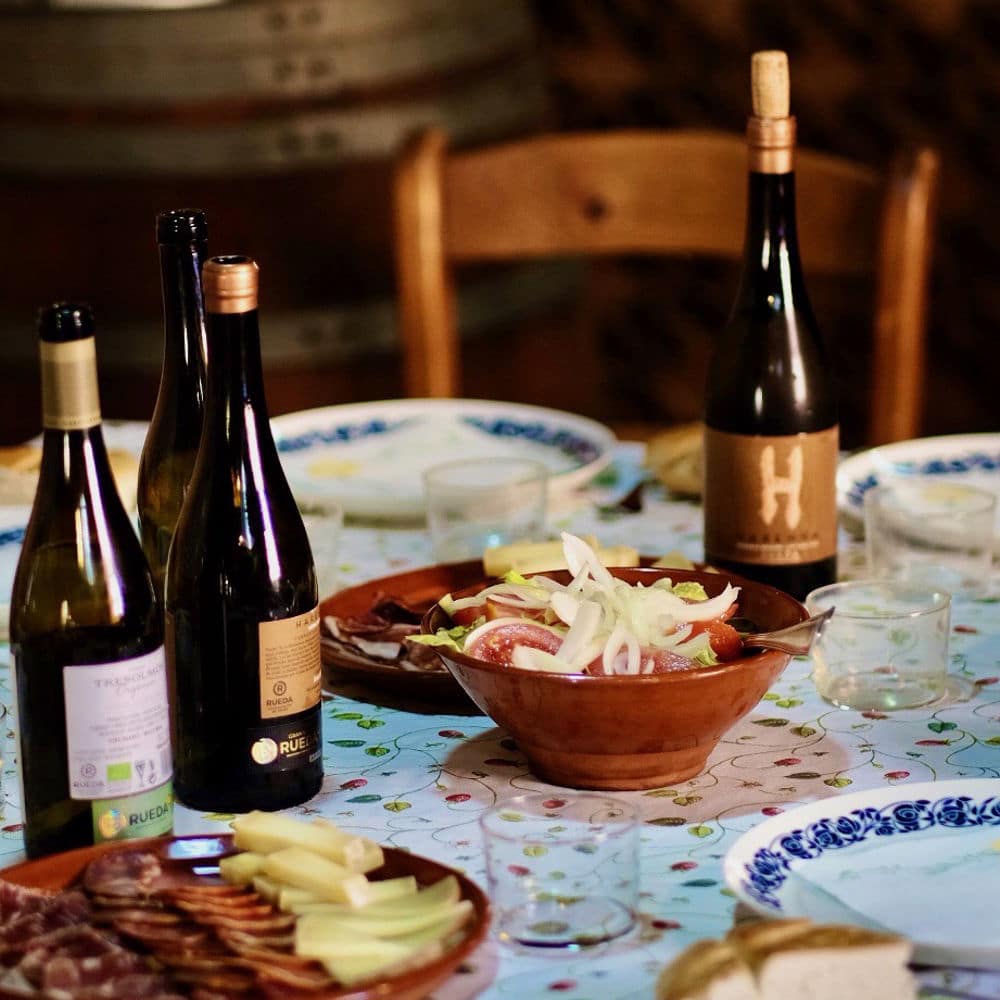A Legacy Rooted in Extremes
Situated on Spain’s Meseta Central, roughly two hours north of Madrid, Ribera del Duero and Rueda grow grapes in one of the most extreme climates in European viticulture. At altitudes reaching over 2,600 feet, the region experiences blistering hot days and bone-chilling nights—a diurnal swing that slows ripening, intensifies flavor, and preserves acidity.
And while water is scarce, soul is abundant. These aren’t easy places to grow wine. They are, however, the right places. In Ribera, some vines stretch past 100 years old, producing Tempranillo (locally called Tinto Fino) that’s revered for its concentration and age-worthiness. In Rueda, Verdejo thrives in sandy soils and stony terrain, often harvested at night to maintain its electric freshness.
Tempranillo: Spain’s Soul, Refined
Tempranillo may be Spain’s flagship red grape, but it wears its heart differently depending on its home. While Rioja expresses the grape with polished elegance, Ribera del Duero channels raw power and sophistication. This is Tempranillo with altitude—structured, savory, and textured.
As Wine Spectator notes, “Ribera del Duero Tempranillo offers bold tannins and dark fruit character with a backbone that rewards cellaring.” Indeed, wines from producers like Vega Sicilia and Dominio de Pingus are now among the most coveted in Europe.
Yet Ribera isn’t just about the high end. Its Crianza and Joven expressions offer accessible elegance—ripe cherry, clove, leather—at price points ideal for by-the-glass programs.
Sommelier Insight: Ribera is a revelation for wine lists. Its range from vibrant Joven to brooding Gran Reserva makes it versatile in pairings—from flame-grilled lamb to wild mushroom risotto.
Verdejo: Spain’s #1 White for a Reason
If Tempranillo is the king, Verdejo is the queen—and in Rueda, she rules with grace and grit. Known for its crisp acidity, herbal lift, and stone fruit notes, Verdejo is Spain’s top-selling white wine. But its success isn’t just about volume—it’s about versatility.
Modern Verdejos run the gamut: zippy stainless-steel versions for sipping on patios, lees-aged expressions with creamy texture, and even barrel-aged renditions that stand shoulder to shoulder with premium Sancerre or Bordeaux Blanc.
In 2023, Wine Enthusiast awarded 34 Rueda Verdejos a score of 90+ points. José Andrés called it “one of the absolute best wines for food” in his newsletter Longer Tables. And Decanter praised its complexity, calling it “a white with layers well worth exploring.”
Trade Tip: Verdejo belongs on every progressive wine list. It delivers Sancerre vibes with a Spanish soul—and at a fraction of the cost.
Terroir That Tells a Story
The soils of Ribera and Rueda are more than geology—they’re narrative threads in a centuries-old story. Ribera’s clay-limestone and gravel terraces infuse wines with minerality and structure. Rueda’s sandy and pebbly soils contribute to Verdejo’s signature vibrancy and allow for the survival of pre-phylloxera vines.
These natural assets, combined with a commitment to hand harvesting and sustainability, have made both regions darlings of the international wine community. According to The Drinks Business, Ribera and Rueda are now among the top-performing Spanish D.O.s for export growth and sommelier adoption.
Culture in a Glass
Wine is never just about the wine. In Ribera and Rueda, it’s about castles on the horizon, lions etched into the stone of medieval towns, and the pilgrimage routes of the Camino de Santiago that still guide travelers through vineyard-laced valleys.
The regions’ food traditions are equally compelling. In Ribera, roasted suckling lamb is a rite of passage. In Rueda, seafood tapas and grilled vegetables find their perfect companion in Verdejo. And don’t forget cheese—our downloadable pairing guide includes everything from Manchego with aged Tempranillo to goat cheese with lees-aged Verdejo.
Fun Fact: Rosé (or clarete) has ancient roots in Ribera—some say older than anywhere else in Europe.
Trade & Tourism: Opportunity Awaits
Ribera del Duero is fast becoming a destination to rival Napa and Burgundy. Wine tourism here is still authentic, unspoiled by crowds. With its cobblestoned villages, castle-cellared wines, and harvest festivals that dance to the rhythm of tradition, Ribera invites you to taste and stay awhile.
For restaurant owners, adding Ribera and Rueda to your list signals a commitment to quality and curiosity. For sommeliers, it’s a playground of terroir and texture. And for retailers, these wines offer premium quality at compelling price points—ideal for adventurous consumers and savvy collectors alike.
Pour the Future: Why This Story Matters to You
🍷 If you’re a sommelier:
Ribera and Rueda offer range, distinction, and narrative depth. Elevate your wine program with bottles that educate and delight.
🍽️ If you’re a restaurant or wine bar owner:
Build your BTG (by-the-glass) program with Verdejo and Tempranillo. Showcase lesser-known styles—lees-aged Verdejo, Tempranillo Crianza—with seasonal menus and tasting flights.
🛒 If you’re a consumer:
Ready to move beyond Pinot Grigio or Cabernet? Start with Verdejo’s bright citrus and Ribera’s plush red fruit. Then explore deeper with aged bottlings and food pairings. Ask your local retailer or sommelier to help you discover your next favorite.
Ready to Join the Conversation?
📍 Visit our newly updated Ribera y Rueda website
📸 Follow us on Instagram @RiberayRuedaWine
📩 DM us “Verdejo” or “Tempranillo” to get our full food & wine pairing guide
🎟️ Looking to travel? Enter the Win a Trip to Spain Contest hitting the U.S. this summer.
Let’s toast to the wines that are bold, authentic, and undeniably world-class.
Ribera del Duero and Rueda—Spain’s most prestigious wine regions are just a glass away.
